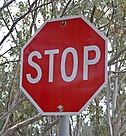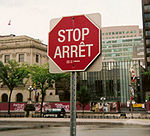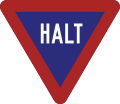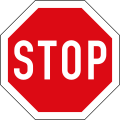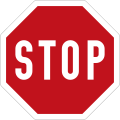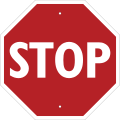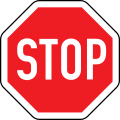Stop sign
The stop sign , formerly Haltschild (in Austria and Switzerland also stop sign ), is a traffic sign that specifies the right of way at road crossings and junctions and instructs road users to stop and give way. The octagonal sign is one of the most internationally used and recognized road signs. The characteristic shape can be recognized by the road user without knowledge of the respective national language and is still recognizable when the surface of the sign is dirty, damaged or covered with snow.
history
The appearance and the lettering were not designed uniformly from the start. Since it was first used in Detroit (USA) in 1915 , different shapes and colors have been tried out, such as white signs with black letters. From 1924 to 1954, yellow stop signs with black letters were used in the United States. The lettering was also different and in some cases it still is today. Although the English term STOP has established itself internationally, in South American countries you can also find labels with PARE or ALTO, in French-speaking Québec (Canada) the sign includes the words ARRÊT. In Turkey , the stop signs contain the word DUR. In addition, some countries use their own characters, sometimes also a bilingual lettering or a hand sign (see comparison ).
The stop sign was introduced in Germany on November 1, 1938. Previously, there was no separate sign for this traffic rule. It consisted of the further developed image 30 (right of way) of the 1937 road traffic regulations , an on top triangle with a red border, which now also received an ultramarine blue inner surface with the white lettering HALT. In the course of international standardization through the Vienna Convention on Road Traffic Signs , various stop sign variants were proposed. On November 8, 1968, numerous countries, including the Federal Republic of Germany , Austria and Switzerland , agreed on the characters B2a and B2b as possible forms of representation of a stop sign. Many countries, Austria and Switzerland were also included, chose the character B2a. In Germany, the old symbol was initially used. With the introduction of new road traffic regulations on March 1, 1971, the B2a sign was declared binding. On May 1, 1971, the German Democratic Republic also joined this regulation with the supplementary agreement to the Convention on Traffic Signs.
- Historic German halt and stop signs
In the Protectorate of Bohemia and Moravia in 1939 introduced variant
- Stop signs of the Vienna Conference 1968
Legal regulations
How road users should behave when there is a stop sign is regulated in the road traffic laws and regulations of the respective country. As a rule, every vehicle - including those in a convoy - has to stop at the stop line . If there is no stop line, you must stop at a point from which the other streets can be seen (so-called line of sight). Right of way must be given after stopping.
As with all right-of-way signs, signs of a traffic light system in operation or a traffic policeman have priority over the sign. Furthermore, if the sign is disregarded, a corresponding warning or fine will be levied (in Germany “unconditional stopping requirement not obeyed”, € 10 without risk or damage).
A special case arises when the stop line is at a traffic light-controlled intersection in front of the so-called line of sight (for arrangement, see adjacent sketch) and the traffic light system is out of order. The German road traffic regulations leave open whether a stop must be made at both the stop line and the line of sight. This special case is not finally clarified in German traffic law. Since there is no complete legal certainty as to whether you have to stop twice or whether a single stop is sufficient, legal experts advise you to stop at both lines.
"The stop sign is located at particularly dangerous junctions or intersections, at which recognition and assessment of the traffic with right of way requires a stop due to the speed being driven and / or the confusing road situation in order to find the time to adequately understand the situation, for example, distance and To be able to estimate the approach speed.
The order is: a) to stop and primarily b) to give right of way if necessary
If the stop line is now relatively far in front of the "line of sight", which is certainly different with a lowered sports car than from the high seat of a truck, then in the case of a "non-stopping obligation" at the (line of sight) where the right-of-way traffic area would be reached in the first place can see that driving behavior is basically the same as in a situation that is "only" given the right of way sign. This lost the sense and advantage of stopping to find the time to grasp the complex situation in its entirety when the vehicle was stationary. "
In the United States, in addition to the stop sign, a red flashing light above the intersection, the flashing red light , has the same (additional) meaning as a traffic light system that is out of order. If the stop sign has the additional sign “3-WAY”, “4-WAY” or “ALL WAY”, the road user who stopped first has right of way after stopping.
The currently valid stop signs in Germany, Austria and Switzerland are listed below:
Stop signs at the Alsterpark in Hamburg
There is a special feature in the Alsterpark in Hamburg. There, stop signs are used by the authorities to ask pedestrians to stop at the pedestrian access to the park area. The signs have the octagonal shape introduced on March 1, 1971. Instead of the word Stop , which has been used since then, the word Halt , known from the older stop signs, is used there . In 2016, this variant, which is not listed in the StVO, was renewed with the word Halt .
See also
Web links
- Regulatory sign according to § 52 StVO in Austria
- Text for sign 206 of the StVO in Germany
- Gallery with various stop signs from all over the world
Individual evidence
- ↑ Colors Magazine: 1000 Signs . Taschen Verlag, Cologne 2004, ISBN 3-8228-3135-2 , pp. 88 .
- ↑ Manual of traffic signs - Were STOP signs ever yellow? Retrieved February 22, 2013 .
- ^ Reichsgesetzblatt , year 1938, No. 168, date of issue: Berlin, October 17, 1938, p. 1434.
- ^ Vienna Convention on Road Traffic. Retrieved February 22, 2013 .
- ↑ Examples of the Vienna Protocol for the Representation of Traffic Signs. (No longer available online.) Archived from the original on March 10, 2013 ; Retrieved February 22, 2013 . Info: The archive link was inserted automatically and has not yet been checked. Please check the original and archive link according to the instructions and then remove this notice.
- ↑ Where do you have to stop when the traffic lights are out of order? Comment on fahrtipps.de . Retrieved February 22, 2013 .
